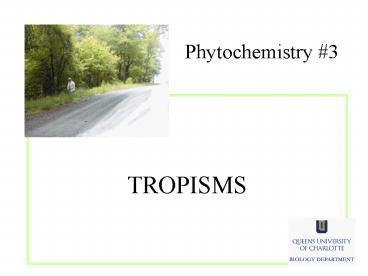TROPISMS - PowerPoint PPT Presentation
1 / 14
Title:
TROPISMS
Description:
an easy online 'textbook' like this: http://www.hcs.ohio-state.edu/hcs300/signal. ... Listen and watch in class, especially when we have videos (http://sunflower.bio. ... – PowerPoint PPT presentation
Number of Views:159
Avg rating:3.0/5.0
Title: TROPISMS
1
Phytochemistry 3
- TROPISMS
2
Tropisms were first
discussed by Darwin
in 1881 (The Power
of Movement in Plants).
- Tropisms are movements or directional growth in
direct response to environmental factors
3
- Tropisms and
other - changes help plants (and other life forms too)
- deal with changing physical factors in their
- environments. These "behaviors" are also
- important for interacting with pollinators,
- predators, seed dispersers, and competitors.
4
- be able to explain in simple English HOW
(mechanisms) - and
- WHY (specific value to the plant)
- the tropisms and other responses work
5
(No Transcript)
6
(No Transcript)
7
TROPISMS
- Morphogenesis is maybe a better name for tropisms
or similar responses which involve a change in
growth - Nastic movements and ___-nasty are terms
sometimes used for reversible changes (see chart
)
8
STIMULUS LIGHT?
- Duration (photoperiod) and color and intensity
all matter. Phytochromes sense red and far-red. - Two types of receptors are sensitive to blue
light - .Phototropins (PHOT1, etc.) are involved in
phototropism, chloroplast motion toward optimal
light intensity, and stomatal opening and their
mutant genes are called nph-1, nph-2 etc. (for
non-phototropic hypocotyl) - Cryptochromes (genes called cry-1 etc.) are
involved in circadian rhythms (in us, too)and
photomorphogenesis
9
To understand tropisms, etc.
- Read some of these
- an easy online textbook like this
http//www.hcs.ohio-state.edu/hcs300/signal.htm - and maybe a harder textbook
- like this http//www.rrz.uni-hamburg.de/biologie
/b_online/e31/31.htm - or a big botany textbook, preferably less than
half your age (several are in the lab and one
should be on your shelf or desk or under your
bed)
10
To understand tropisms, etc.
- Try to translate some excerpts from research
reports, including those for hormones (above) and
those on your print-out or at http//www.queens.ed
u/faculty/jannr/Botany/phytochem.htm.
11
To understand tropisms, etc.
- Fill in and learn the chart
12
(No Transcript)
13
To understand tropisms, etc.
- Ask questions about the chart Friday
14
To understand tropisms, etc.
- Listen and watch in class, especially when we
have videos (http//sunflower.bio.indiana.edu/rha
ngart/plantsinmotion.html)































